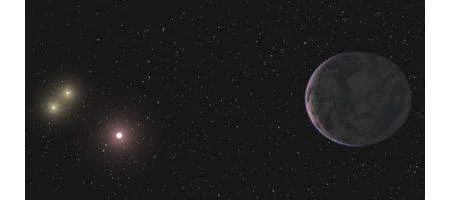Astronomers have discovered a potentially habitable planet right on our doorstep – just 22 light years away.

Orbiting its star in about 28 days, it has a mass at least 4.5 times that of the Earth, putting it firmly in the habitable zone, where it’s neither too hot nor too cold for liquid water to exist on the planet’s surface.
There’s at least one – and possibly two or three – other planets orbiting the star.
The discovery shows that habitable planets may be more widespread than thought – the host star has a lot fewer elements heavier than helium, such as iron, carbon, and silicon, than our own sun. These are the elements that planets are made of.
The host star, called GJ 667C, is an M-class dwarf star. The other two stars in the triple-star system (GJ 667AB) are a pair of orange K dwarfs, with a concentration of heavy elements only 25 percent that of our sun’s.
“This was expected to be a rather unlikely star to host planets. Yet there they are, around a very nearby, metal-poor example of the most common type of star in our galaxy,” says UC Santa Cruz astronomer Steven Voght.
“The detection of this planet, this nearby and this soon, implies that our galaxy must be teeming with billions of potentially habitable rocky planets.”
GJ 667C had previously been observed to have a super-Earth (GJ 667Cb) with a period of 7.2 days – although this finding was never published. This planet, though, orbits so close to the star that it would be too hot for liquid water.
But, while they were collecting data on this planet, the research team found the clear signal of a new planet – given the catchy name of GJ 667Cc – in the Goldilocks zone. It receives 90 percent of the light that Earth receives; however, because most of its incoming light is in the infrared, more of this incoming energy should be absorbed by the planet, giving it about the same amount as the Earth absorbs from the sun.
“This planet is the new best candidate to support liquid water and, perhaps, life as we know it,” says Guillem Anglada-Escudé, now at the University of Gottingen.
The team found that the system might also contain a gas-giant planet and an additional super-Earth with an orbital period of 75 days – but say they need to make further observations to confirm this.
“With the advent of a new generation of instruments, researchers will be able to survey many M dwarf stars for similar planets and eventually look for spectroscopic signatures of life in one of these worlds,” says Anglada-Escudé.
The researchers used public data from the European Southern Observatory and analyzed it with a novel data-analysis method. They also incorporated new measurements from the W M Keck Observatory’s High Resolution Echelle Spectrograph and the new Carnegie Planet Finder Spectrograph at the Magellan II Telescope.






